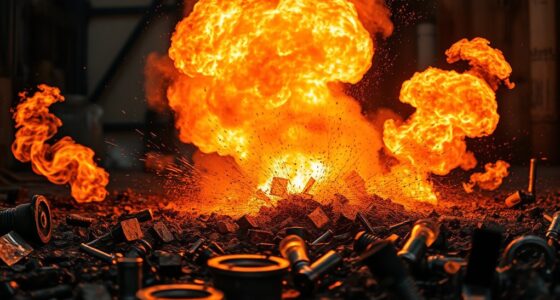Some chemicals are dangerous because they can harm your health through different exposure routes like air, water, or contact, especially over long periods. They may also react explosively or generate toxic fumes when combined or handled improperly. Certain chemicals persist in the environment and build up in living organisms, increasing risks over time. Understanding these dangers helps you stay safe, and exploring further reveals how proper storage, classification, and safety measures can protect you and your community.
Key Takeaways
- Some chemicals are inherently toxic, damaging cells or organs upon exposure or ingestion.
- Chemical reactivity can cause physical hazards like explosions, fires, or the release of toxic gases.
- Long-term exposure to certain chemicals can lead to chronic health issues such as cancer or neurological damage.
- Persistent chemicals resist degradation, bioaccumulate, and contaminate ecosystems, posing risks to wildlife and humans.
- Improper storage, labeling, or handling can lead to accidental releases or exposures, increasing danger.
The Impact of Toxic Substances on Human Health
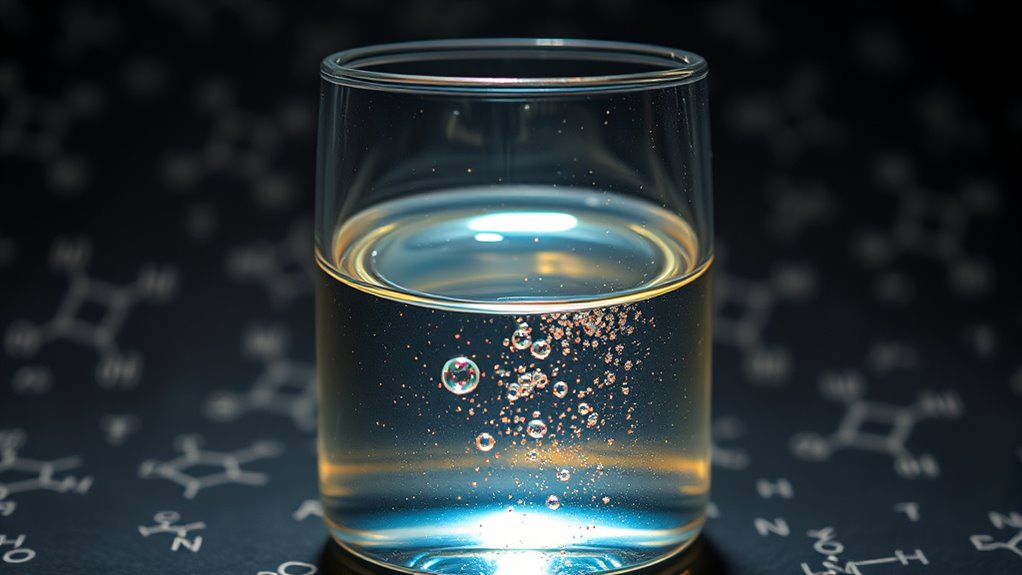
Have you ever wondered how chemicals in our environment affect your health? Exposure pathways, like air, water, and contact, allow toxins to enter your body. When chemicals work together through chemical synergy, their combined effects can be more damaging than alone. For example, air pollution and occupational hazards have caused millions of deaths worldwide, with long-term exposure increasing risks for chronic diseases like cancer and organ damage. Chemicals such as PFAS, benzene, and asbestos persist in your body and environment, often accumulating over time. Vulnerable populations, including children and low-income communities, face higher risks due to repeated exposure through contaminated water and air. Understanding these exposure pathways and chemical synergy helps explain why some chemicals pose such serious threats to your health over the long term. The global burden of disease from chemical exposure underscores the urgent need for effective management and preventive strategies.
How Reactivity Causes Physical Hazards
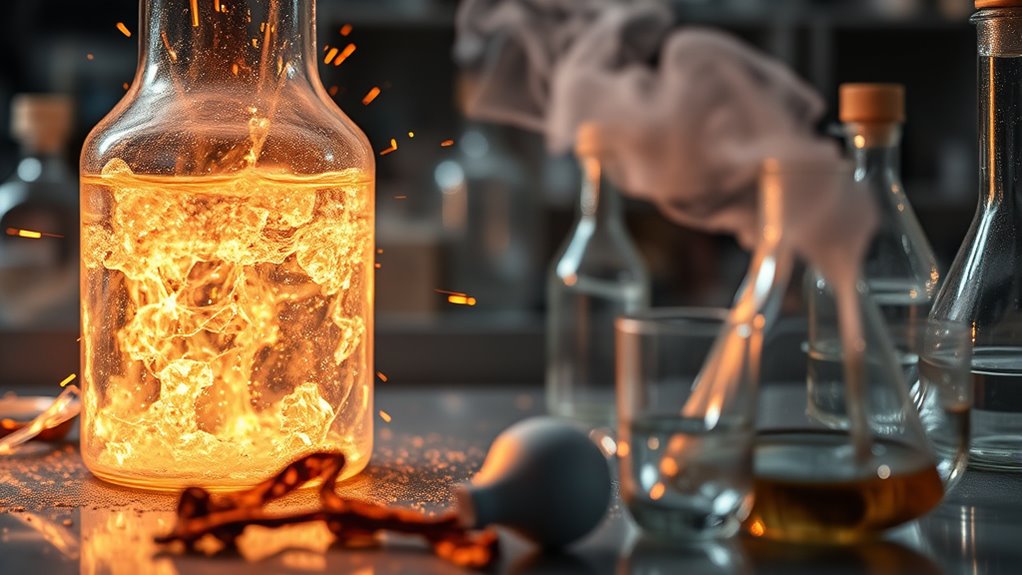
Chemical reactivity can create serious physical hazards that threaten safety in industrial and everyday settings. Reactive hazards can lead to physical explosions when sudden energy releases occur through shock, heat, or pressure. These reactions often produce instant gas and heat, causing containers to rupture or explode. Uncontrolled reactions, like thermal runaway or supersack ignition, can trigger fires or violent blasts. Water-reactive chemicals emit flammable or toxic gases and generate exothermic heat, increasing pressure hazards. Unstable reactive materials, such as shock-sensitive compounds and peroxides, can detonate unexpectedly, especially under impact or temperature changes. Improper mixing may produce toxic gases, chain reactions, or volatile compounds, escalating risks. These physical hazards, amplified by gas expansion, corrosion, and oxidizer-fuel interactions, pose significant dangers that require careful handling and safety measures. Understanding the specific reactivity properties of chemicals is essential to prevent accidents and minimize risks, as reactivity directly influences the severity of physical hazards. Additionally, reactive stability can be compromised by environmental factors, making proper storage crucial to avoid unintended reactions. For instance, AI-driven safety monitoring systems are increasingly used to detect early signs of hazardous reactions and prevent accidents.
The Role of Biological Activity in Chemical Toxicity

Ever wonder how substances cause harm inside your body? The key lies in molecular binding, where chemicals attach to cellular components like proteins, nucleic acids, or lipids. This interaction can disrupt normal cellular functions, leading to toxicity. For example, some toxicants bind to enzymes’ active sites, causing enzymatic disruption that impairs essential biochemical processes. Heavy metals like lead and mercury target sulfhydryl groups in proteins, altering their structure and function. These molecular interactions can interfere with cellular signaling, energy production, or DNA integrity, triggering harmful effects. By understanding how chemicals bind to biological molecules and disrupt enzyme activity, scientists can better predict toxic outcomes and develop safer chemicals. This knowledge is crucial for evaluating chemical risks and protecting health from harmful substances.
Chronic Exposure and Long-Term Health Risks
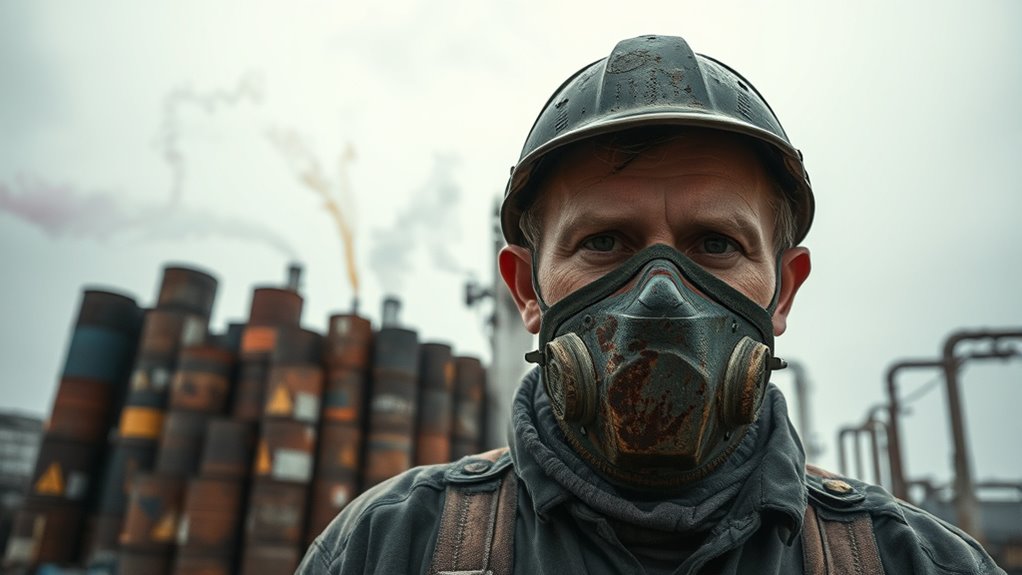
Long-term exposure to hazardous substances can cause serious health problems that develop over years rather than days or weeks. Proper chemical labeling helps you identify risks and understand exposure pathways, such as inhalation, skin contact, or ingestion. Continuous exposure can lead to cancer, respiratory issues like asthma, neurological damage, reproductive problems, and cardiovascular diseases. These health risks often go unnoticed until symptoms appear after years of contact. Vulnerable populations, like children, pregnant women, and low-income communities, face higher risks. The long-term effects not only affect individual health but also add to economic costs through healthcare and lost productivity. Recognizing exposure pathways and maintaining accurate chemical labeling are vital steps in reducing chronic health risks associated with hazardous chemicals. Additionally, using air purifiers with HEPA filters can help reduce airborne pollutants that contribute to long-term health issues.
Persistence and Bioaccumulation in the Environment

Many hazardous substances resist breakdown in the environment due to specific mechanisms that make them persistent. Chemicals with halogen atoms, like chlorine or fluorine, resist degradation by sunlight, reactions, or microbes. They often have half-lives longer than two months in water, soil, or sediment, or more than two days in air, with very persistent ones lasting over six months. These substances undergo environmental transport, moving through air and water currents over long distances, even reaching polar regions. In sediment reservoirs, hydrophobic compounds bind to organic matter, creating long-term sinks that can re-release pollutants through erosion or climate effects. Persistence mechanisms allow these chemicals to remain in ecosystems for extended periods, amplifying their potential harm over time. Additionally, the bioaccumulation of these substances in living organisms can lead to higher concentrations up the food chain, increasing risks to both wildlife and humans. Some of these chemicals can also undergo chemical transformations in the environment, forming more toxic or persistent derivatives, which complicates cleanup efforts and risk assessments. These transformations can produce more harmful compounds, further aggravating environmental and health hazards. Metals like lead, mercury, and arsenic persist indefinitely, contributing to ongoing environmental contamination and exposure risks. Moreover, their resistance to degradation means they can accumulate in ecosystems for generations without breaking down naturally.
Regulatory Classifications and Safety Measures
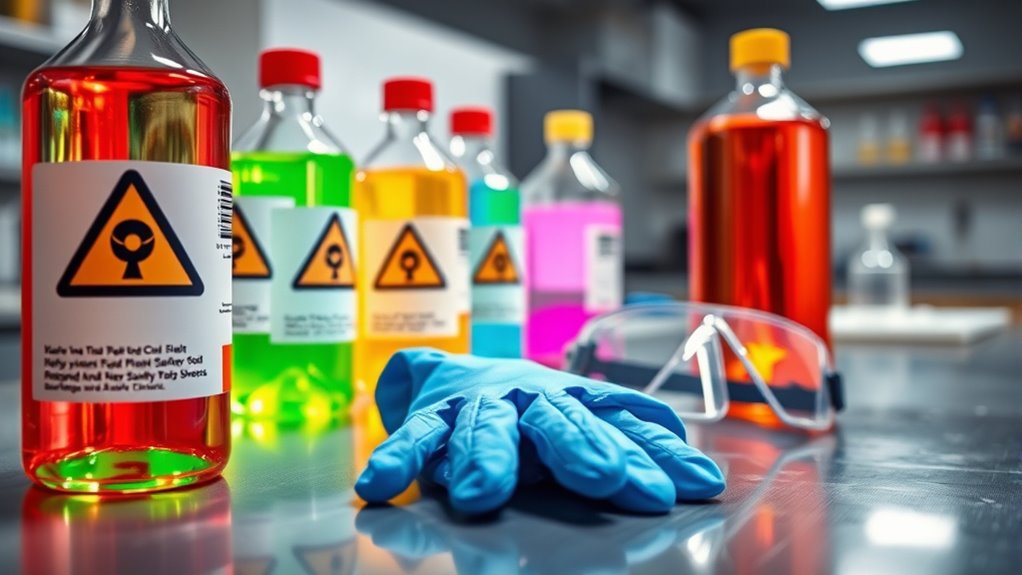
Understanding how hazardous chemicals are classified and communicated is key to ensuring safety. Regulatory classifications, such as those mandated by the Hazard Communication Standard (HCS) and the Globally Harmonized System (GHS), create a consistent framework for identifying chemical hazards worldwide. These classifications are communicated through Safety Data Sheets (SDS), labels, and pictograms, providing clear safety measures for handling and storage. Proper classification helps you quickly recognize risks and follow safety protocols, reducing accidents and exposure. Regulations like OSHA, REACH, and the EU’s CLP ensure compliance, promoting safer workplaces and smoother international trade. By adhering to these safety measures, you protect yourself, others, and the environment from the dangers of hazardous chemicals. Understanding chemical classifications and proper safety communication help foster a safer environment for all. The standardized hazard communication elements facilitate international trade by ensuring that safety information is understood across different countries and languages. Incorporating classification systems enhances the clarity and consistency of hazard information, making compliance more efficient worldwide. Additionally, applying mindfulness techniques can improve awareness and careful handling of chemicals in the workplace, thereby reducing potential accidents. Developing attention skills can further enhance safety practices and prevent mishandling of hazardous substances. Being aware of regulatory requirements ensures that safety protocols are properly followed and that chemical hazards are properly communicated to all personnel.
The Dangers of Chemical Interactions and Reactions
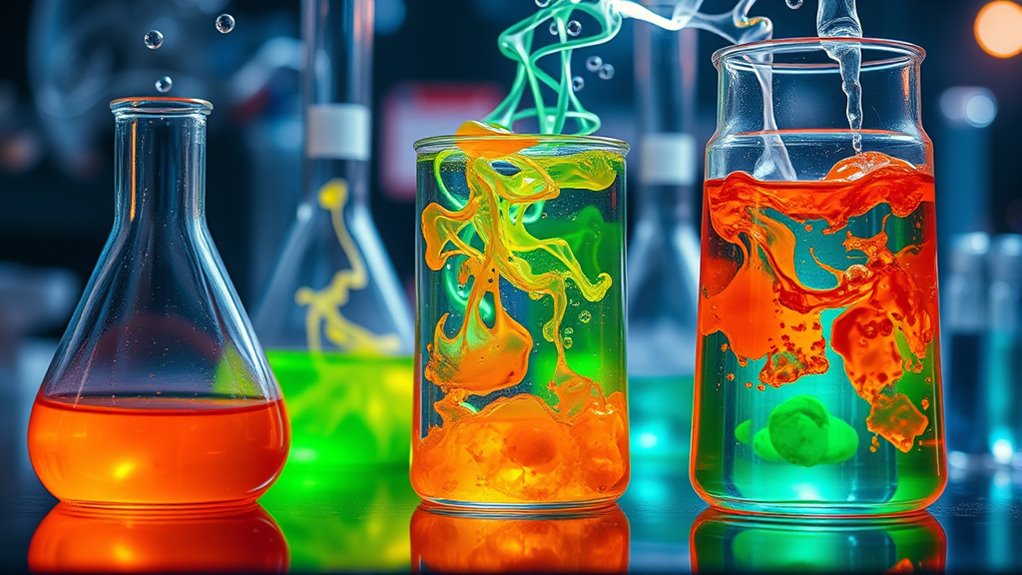
Chemical interactions can pose serious dangers if not properly managed, as mixing certain substances may produce toxic fumes, fires, or explosions. Understanding chemical reactivity is key to hazard prevention. For example, mixing strong acids and bases can generate heat and hazardous gases, while combining oxidizing agents with reducing agents may cause explosive reactions. Household products like bleach and ammonia produce toxic gases that can harm your respiratory system. Inadequate ventilation can lead to dangerous gas buildup, increasing the risk of suffocation or explosions. To prevent accidents, always check chemical compatibility, follow safety guidelines, and use proper storage. Recognizing how different chemicals react can help you prevent dangerous situations before they happen. Proper chemical compatibility checks and understanding reactivity are essential for safety in any environment. Wearing PPE and having emergency plans in place are essential steps to minimize risks. Additionally, understanding chemical properties can further aid in assessing potential hazards and ensuring safe handling practices. Developing a thorough knowledge of chemical reactions enables better anticipation of potential hazards and enhances overall safety measures. Staying informed about toxic substances is also crucial for immediate response during accidental exposures.
Why Certain Chemicals Are More Potent Than Others

Ever wonder why some chemicals are more dangerous than others? It all comes down to their chemical structure and functional groups. The structure determines how easily a chemical can enter your cells or bind to biological targets, influencing its toxicity. Functional groups, specific parts of a molecule, can make a chemical more reactive or better at attaching to essential enzymes or receptors. For example, certain groups may increase a chemical’s ability to dissolve in fats, helping it pass through cell membranes faster. Additionally, reactive functional groups can form harmful compounds inside your body. The combination of chemical structure and functional groups influences how a chemical interacts with your biological systems, making some substances far more potent—and dangerous—than others. Understanding chemical interactions is crucial for assessing potential risks, especially when considering biological effects and how chemicals can disrupt normal bodily functions. Recognizing how molecular reactivity impacts toxicity helps in developing safer chemicals and treatments. Moreover, interior design principles can be applied to create safer environments by minimizing exposure to hazardous substances.
The Significance of Chemical Storage and Handling
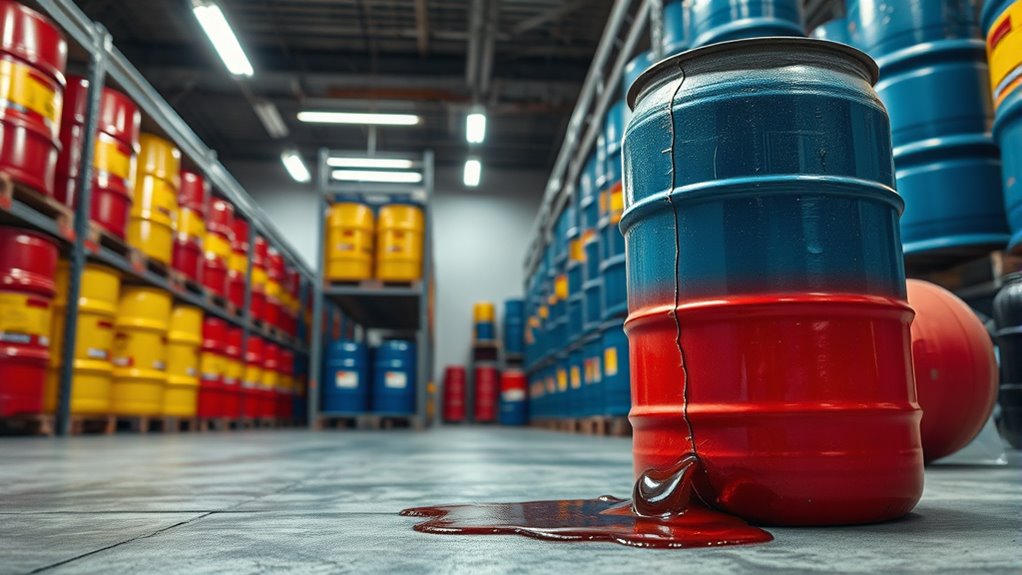
Proper storage and handling of chemicals are essential to maintaining safety in any environment. You need to ensure that storage locations are dry, well-ventilated, and kept away from heat sources to prevent fires, explosions, or chemical degradation. Chemicals should be separated based on compatibility, such as acids from bases or oxidizers from flammable solids, to avoid dangerous reactions. Clear chemical labeling is vital for quick identification and safety, indicating chemical names, hazards, and precautions. Maintaining an accurate inventory helps manage hazards and controls access. Always store flammable liquids in approved cabinets and keep bottles off the floor unless in secondary containment. Store materials per manufacturer’s specifications in designated locations. Proper storage, labeling, and handling practices help prevent accidents, protect personnel, and reduce environmental risks. Implementing environmental considerations such as proper waste disposal and spill response plans further enhances safety measures. Additionally, understanding the cultural impact of technology can inform safer practices and foster innovation in safety protocols.
Protecting Communities From Chemical Hazards
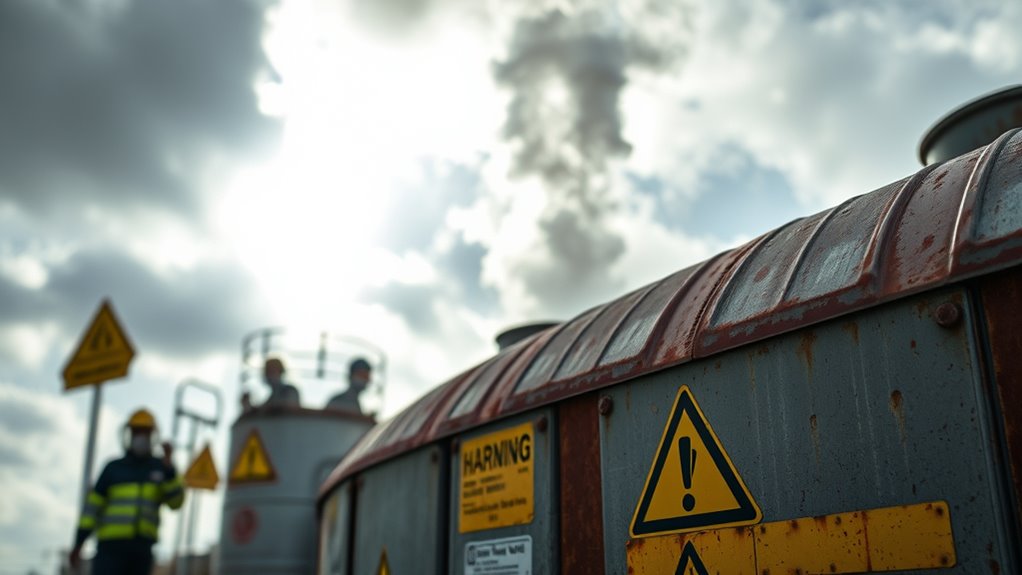
Safe storage and handling practices play a key role in reducing community exposure to hazardous chemicals. Proper chemical labeling guarantees everyone understands the risks, helping prevent accidents and enabling quick response during emergencies. Emergency preparedness plans are essential; knowing evacuation routes, shelter-in-place procedures, and decontamination protocols can save lives. Communities near industrial zones, especially marginalized ones, face higher risks from incidents involving ammonia, carbon monoxide, or other hazardous substances. Regular training for responders and clear public health communication improve safety. Authorities can also strengthen regulations like the EPA’s Risk Management Program, focusing on accurate safety data sheets and hazard assessments. Research shows that accurate chemical hazard warnings are essential for effective emergency response. By prioritizing chemical labeling and emergency preparedness, you help protect your community from the devastating impacts of chemical hazards.
Frequently Asked Questions
How Do Chemicals Enter and Spread Within Ecosystems?
You see how chemicals enter and spread within ecosystems through various pathways. They can be directly ingested or absorbed via skin, while airborne chemicals disperse through wind, contaminating air and water. Transport mechanisms like hydrological flow and sediment adsorption carry pollutants across environments. Over time, chemical bioaccumulation builds up in organisms, leading to ecosystem contamination, which disrupts wildlife behavior, physiology, and biodiversity, ultimately impacting the health of entire ecosystems.
What Factors Influence a Chemical’S Ability to Cause Long-Term Health Effects?
You need to contemplate how chemical persistence and bioaccumulation potential impact long-term health effects. Persistent chemicals stay in the environment and your body longer, increasing exposure risks. Bioaccumulation causes chemicals to build up in your tissues over time, heightening health concerns. Factors like concentration, duration, and route of entry also matter, as well as your individual sensitivity. All these elements together determine how likely a chemical is to cause lasting health issues.
Why Are Some Chemicals More Resistant to Degradation Than Others?
Imagine a fortress built with unyielding walls—that’s how some chemicals resist degradation. Your understanding of chemical stability reveals the strength of their molecular bonds, while environmental persistence shows how long they linger in nature. These resilient chemicals, with stable structures and low permeability, withstand harsh conditions and resist breakdown. Their durability becomes a silent sentinel, making them formidable foes against natural decay and ensuring they remain in the environment far longer than others.
How Do Accidental Chemical Reactions Escalate Hazards in Industrial Settings?
You need to understand that accidental chemical reactions can quickly escalate hazards by compromising chemical containment and reaction control. When reactions become uncontrolled, heat and pressure build up, risking explosions or fires. Poor hazard analysis or outdated safety protocols often fail to detect these risks. Without proper containment measures and reaction control, even minor incidents can trigger significant damage, endangering workers, the environment, and the facility itself.
What Makes Certain Chemicals More Toxic at Lower Doses?
Imagine a tiny spark igniting a flame—some chemicals are like that, highly potent even at low doses. Their chemical structure affects their ability to interfere with your body’s functions, creating a steep dose response relationship. This means a small amount can cause significant harm, especially if exposure occurs during sensitive periods. Recognizing chemical potency helps you understand why certain substances are dangerous, even in tiny quantities.
Conclusion
So, next time you marvel at a sparkling chemical lab or breathe in that fresh paint smell, remember—these substances are just itching to cause chaos. Their reactivity, persistence, and sneaky bioaccumulation make them the perfect villains in your health story. Handle them with care, or enjoy being part of the grand experiment on how much danger you can safely ignore. After all, who doesn’t love a little hazardous fun?



